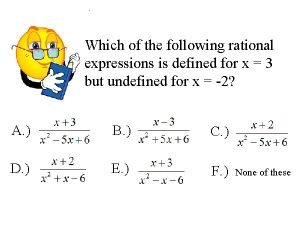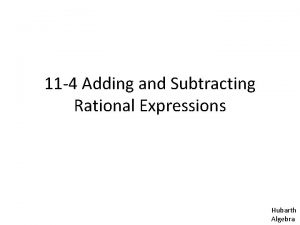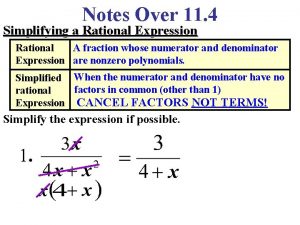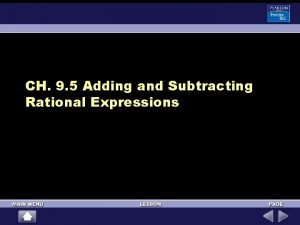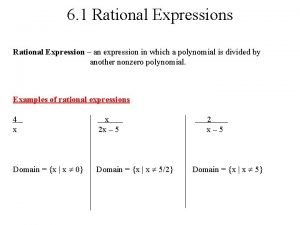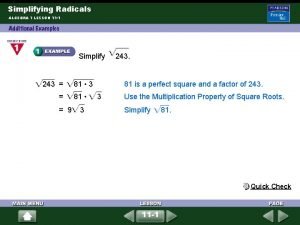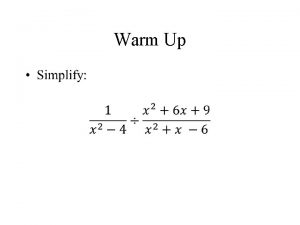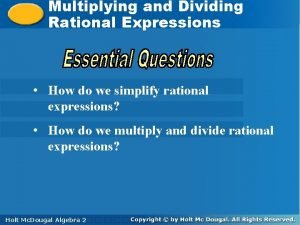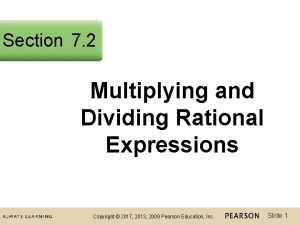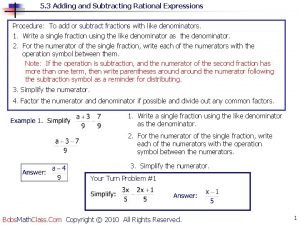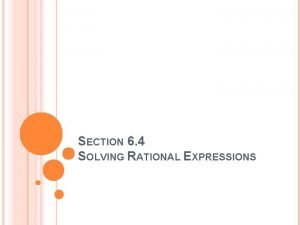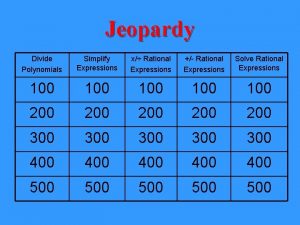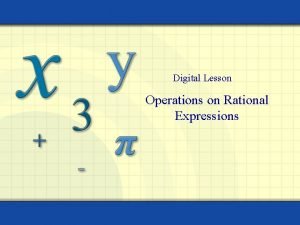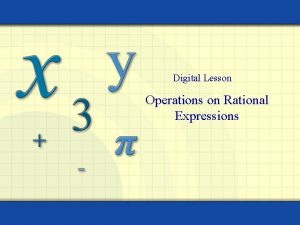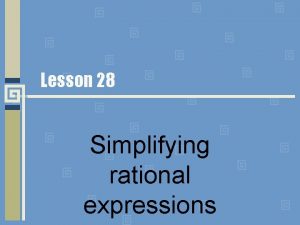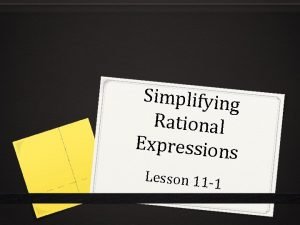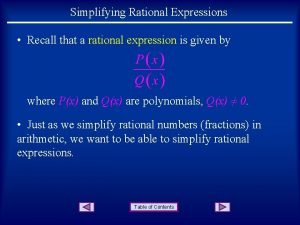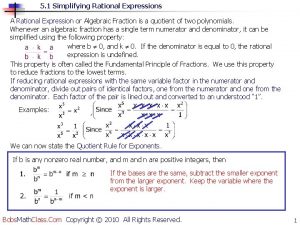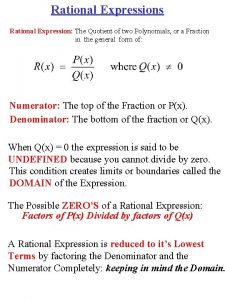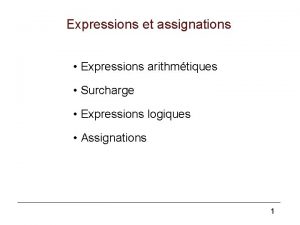6 1 Rational Expressions Rational Expression an expression























- Slides: 23

6. 1 Rational Expressions Rational Expression – an expression in which a polynomial is divided by another nonzero polynomial. Examples of rational expressions 4 x x 2 x – 5 Domain = {x | x 0} Domain = {x | x 5/2} 2 x– 5 Domain = {x | x 5}

Graph of a Rational Function y= 1 x x -2 -1 -1/2 0 ½ 1 2 y -1/2 -1 -2 Undefined 2 1 ½ The graph does not cross the x = 0 line since x the graph is undefined there. . The line x = 0 is called a vertical asymptote. An Application: Modeling a train track curve.

Multiplication and Division of Rational Expressions A • C = A B • C B 9 x 3 x 2 5 y – 10 = 5 (y – 2) 10 y - 20 10 (y – 2) 2 z 2 – 3 z – 9 z 2 + 2 z – 15 A 2 – B 2 A+B 3 x = 5 =1 10 2 = (2 z + 3) (z – 3) (z + 5) (z – 3) = = (A + B)(A – B) (A + B) = 2 z + 3 z+5 = (A – B)

Negation/Multiplying by – 1 -y – 2 4 y + 8 = y+2 4 y + 8 OR -y - 2 -4 y - 8


Check Your Understanding Simplify: x 2 – 6 x – 7 x 2 -1 1 x-2 (x + 1) (x – 7) (x – 1) 1 x– 2 3 x 2 + x - 6 3 • • (x + 3) 3 (x + 3) (x – 2) 3

6. 2 Addition of Rational Expressions Adding rational expressions is like adding fractions With LIKE denominators: 1 8 + x x+2 x 3 x 2 + 4 x - 4 2 8 + + = 3 x - 1 x+2 = 3 8 4 x - 1 x+2 2 (2 + x) = = 3 x 2 + 4 x -4 (3 x 2 + 4 x – 4) (3 x -2)(x + 2) = 1 (3 x – 2)

Adding with UN-Like Denominators 3 4 1 x 2 – 9 + 1 8 (3) (2) 8 + 6 8 1 8 + 7 8 1 8 + 2 x+3 1 (x + 3)(x – 3) + 2 (x + 3) 1 (x + 3)(x – 3) + 2 (x – 3) (x + 3)(x – 3) 1 + 2(x – 3) (x + 3) (x – 3) = 1 + 2 x – 6 (x + 3) (x – 3) = 2 x - 5 (x + 3) (x – 3)

Subtraction of Rational Expressions To subtract rational expressions: Step 1: Get a Common Denominator Step 2: Combine Fractions DISTRIBUTING the ‘negative sign’ BE CAREFUL!! 2 x x 2 – 1 = - x– 1 (x + 1)(x – 1) x+1 x 2 - 1 = = 2 x – (x + 1) x 2 -1 1 (x + 1) = 2 x 2 – x - 1 x -1

Check Your Understanding Simplify: b 2 b - 4 b-1 b-2 - b 2(b – 2) - b-1 b-2 b 2(b – 2) + -b+1 b-2 b 2(b – 2) + 2(-b+1) 2(b – 2) b – 2 b+2 2(b – 2) = -b + 2 2(b – 2) = -1(b – 2) 2(b – 2) = -1 2

6. 3 Complex Fractions A complex fraction is a rational expression that contains fractions in its numerator, denominator, or both. Examples: 1 5 x x 2 – 16 1 x + 2 x 2 4 7 1 x-4 3 x - 1 x 2 7/20 x x+4 x+2 3 x - 1

6. 4 Division by a Monomial 3 x 2 + x x 4 x 2 + 8 x – 12 4 x 2 15 A 2 – 8 A 2 + 12 4 A 5 x 3 – 15 x 2 15 x 5 x 2 y + 10 xy 2 5 xy 12 A 5 – 8 A 2 + 12 4 A

Polynomial Long Division Example: Divide 4 – 5 x – x 2 + 6 x 3 by 3 x – 2. Begin by writing the divisor and dividend in descending powers of x. Then, figure out how many times 3 x divides into 6 x 3. Multiply. 3 x – 2 2 x 2 6 x 3 – x 2 – 5 x + 4 6 x 3 – 4 x 2 3 x 2 – 5 x Divide: 6 x 3/3 x = 2 x 2. Multiply: 2 x 2(3 x – 2) = 6 x 3 – 4 x 2. Subtract 6 x 3 – 4 x 2 from 6 x 3 – x 2 and bring down – 5 x. Now, divide 3 x 2 by 3 x to obtain x, multiply then subtract. Multiply. 3 x – 2 2 x 2 + x -1 6 x 3 – x 2 – 5 x + 4 6 x 3 – 4 x 2 3 x 2 – 5 x 3 x 2 – 2 x -3 x + 4 -3 x +2 Answer: 2 x 2 + x – 1 + 2 3 x - 2 2 Divide: 3 x 2/3 x = x. Multiply: x(3 x – 2) = 3 x 2 – 2 x. Subtract 3 x 2 – 2 x from 3 x 2 – 5 x and bring down 4. Subtract -3 x + 2 from -3 x + 4, leaving a remainder of 2.

More Long Division 3 x -11 3 3 x + 2 9 x + 9 x -11 x 2 - 5 x - 3 -11 x 2 - 33 x - 33 28 x+30

6. 5 -6. 6 Rational Equations (2 x – 1) 3 x 2 x – 1 (x - 2) = 3 3 x = 3(2 x – 1) 3 x = 6 x – 3 -3 x = -3 x+1 x– 2 (x + 1) = 3 x-2 6 x+1 =x x+1=3 6 = x (x + 1) x=2 6 = x 2 + x x=1 x 2 + x – 6 = 0 (x + 3 ) (x - 2 ) = 0 Careful! – What do You notice about the answer? x = -3 or x=2

Rational Equations Cont… To solve a rational equation: Step 1: Factor all polynomials Step 2: Find the common denominator Step 3: Multiply all terms by the common denominator Step 4: Solve (12 x) x+1 2 x - x– 1 4 x = 1 3 = 6 (x + 1) -3(x – 1) = 4 x 6 x + 6 – 3 x + 3 = 4 x 3 x + 9 = 4 x -3 x 9 = x

Other Rational Equation Examples 3 x– 2 (x + 2)(x – 2) 3 x– 2 + 5 x+2 = 12 x 2 - 4 1 x + 5 x+2 = 12 (x + 2) (x – 2) 4 x + 4 + 1 = 3 x 2 4 3 x 2 - 4 x 3(x + 2) + 5(x – 2) = 3 x + 6 + 5 x – 10 = 8 x – 4 = 12 +4 +4 8 x = 16 x = 2 12 12 (4 x 2) = 3 x 2 - 4 =0 (3 x + 2) (x – 2) = 0 3 x + 2 = 0 or x– 2=0 3 x = -2 or x=2 x = -2/3 or x=2

Check Your Understanding Simplify: x 1 + x 2 – 1 1 x– 2 1 x(x – 1) - 1 x-1 3 x + 1 2(x – 3) x(x – 2) x 2 – 1 - 2 x(x + 1) 3 x(x – 1)(x + 1) Solve 6 - 1 x 2 4 =1 3 2 x – 1 = 2 2 x– 1 + 3 5 x+1 x+2 = x x 2 + x - 2 -1/4 Try this one: Solve for p: 1 =1 + 1 F p q

6. 7 Proportions & Variation Proportion equality of 2 ratios. Proportions are used to solve problems in everyday life. 1. If someone earns $100 per day, then how many dollars can the person earn in 5 days? 100 x (x)(1) = (100)(5) = 5 1 x = 500 2. If a car goes 210 miles on 10 gallons of gas, the car can go 420 miles on X gallons 210 10 3. = 420 x (210)(x) = (420)(10) (210)(x) = 4200 x = 4200 / 210 = 20 gallons If a person walks a mile in 16 min. , that person can walk a half mile in x min. 16 1 = x ½ (x)(1) = ½(16) x = 8 minutes

The Shadow Problem Juan is 6 feet tall, but his shadow is only 2 ½ feet long. There is a tree across the street with a shadow of 100 feet. The sun hits the tree and Juan at the same angle to make the shadows. How tall is the tree? personheight treeheight 6 x = 2. 5 100 personshadow treeshadow 6 ft x 2. 5 x = (100)(6) 2. 5 x = 600 2. 5 x = 240 feet 2 ½ ft 100 ft

7. 6 Direct Variation y = kx y is directly proportional to x. y varies directly with x k is the constant of proportionality Example: y = 9 x (9 is the constant of proportionality) Let y = Your pay Let x – Number of Hours worked Your pay is directly proportional to the number of hours worked. Example 1: Example 2: Salary (L) varies directly as the number of hours worked (H). Write an equation that expresses this relationship. Aaron earns $200 after working 15 hours. Salary = k(Hours) L = k. H Find the constant of proportionality using your equation in example 1. . 200 = k(15) So, k = 200/15 = 13. 33

Inverse Variation y= k x y is inversely proportional to x y varies inversely as x Example: y varies inversely with x. If y = 5 when x = 4, find the constant of proportionality (k) 5 = k 4 So, k = 20

Direct Variation with Power y = kxn y is directly proportional to the nth power of x Example: Distance varies directly as the square of the time (t) Distance = kt 2 D = kt 2 Joint Variation y = kxp • y varies jointly as x and p
 8-1 multiplying and dividing rational expressions
8-1 multiplying and dividing rational expressions 9-1 multiplying and dividing rational expressions
9-1 multiplying and dividing rational expressions Reducing rational expressions to lowest terms
Reducing rational expressions to lowest terms Rational expressions applications worksheet answers
Rational expressions applications worksheet answers 11-4 practice adding and subtracting rational expressions
11-4 practice adding and subtracting rational expressions 11-4 adding and subtracting rational expressions
11-4 adding and subtracting rational expressions Practice 9-5 adding and subtracting rational expressions
Practice 9-5 adding and subtracting rational expressions Lesson 8 complex number division
Lesson 8 complex number division Solving linear rationals with lcm
Solving linear rationals with lcm Complex rational expressions
Complex rational expressions 6x-1 rational or irrational
6x-1 rational or irrational 11-2 simplifying radical expressions answers
11-2 simplifying radical expressions answers Multiplying and dividing rational expressions quizlet
Multiplying and dividing rational expressions quizlet Addition of rational expressions
Addition of rational expressions Simplifying multiplying and dividing rational expressions
Simplifying multiplying and dividing rational expressions How to multiply rational expressions
How to multiply rational expressions 8-3 adding and subtracting rational expressions answer key
8-3 adding and subtracting rational expressions answer key How to add and subtract rational expressions
How to add and subtract rational expressions 11-4 practice multiplying and dividing rational expressions
11-4 practice multiplying and dividing rational expressions How to subtract rational fractions
How to subtract rational fractions 5-6 radical expressions and rational exponents
5-6 radical expressions and rational exponents How to find non permissible values of rational expressions
How to find non permissible values of rational expressions Simplifying expressions jeopardy
Simplifying expressions jeopardy 5-6 radical expressions and rational exponents
5-6 radical expressions and rational exponents



